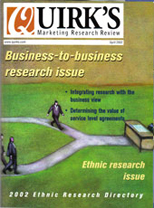Editor's note: Jane Sheppard is director of respondent cooperation at the Council for Marketing and Opinion Research.
The Hispanic population is the largest growing minority population in the United States. According to the 2000 Census statistics, one in eight people are of Hispanic origin, yet fewer of these individuals have ever participated in surveys according to the 2001 CMOR Respondent Cooperation & Industry Image Study. For the first time since CMOR (the Council for Marketing and Opinion Research) has been fielding the study, the sample of Hispanics was large enough to support some comparisons with the non-Hispanic population. The continuing growth of this ever-important segment of the population, with their differing attitudes and behavior, needs to be well understood by researchers in order to determine the most effective survey modes to reach them.
The Hispanics in our survey showed a more positive attitude toward surveys and polls. They seemed to understand the value of research and the benefit to them and to manufacturers. This group appreciates the opportunity to provide feedback, as evidenced in the fact that fewer Hispanics refused a survey in the past year than non-Hispanics.
The Hispanic cultures are generally known for their preference for face-to-face communication, where trust can be established more easily. This was reflected in their preference for in-person survey modes in malls, and focus groups conducted both in central locations and online, where group dynamics are key.
Telephone methods fare worse among Hispanics than non-Hispanics based upon respondents whose last survey experience was conducted by phone. They felt that the surveys were too long, the questions were too personal, and that the interviewer was less courteous and professional. This may stem from the lack of face-to-face contact or group dynamic; facility with English may come into play as well. The study was conducted in English and this distrust may not hold true if done in Spanish. It also could be more difficult to reach them by telephone since they use answering machines more frequently to screen calls than the non-Hispanic population.
Researchers are recognizing that this ascendant population segment is an important target for products and services - well worth the different treatment they may require in market research settings. Hispanics show a very positive disposition to surveys and polls, and believe strongly in the results that are published. They are positively predisposed to TV and newspaper stories that use survey data and like to compare their own opinions with those published.
Our findings show that different survey modes are important to reach different populations and, despite concerns by some in our industry, the lower-tech "traditional" data collection techniques still have effective applications. In the Hispanic population, we have people interested in sharing their opinions with market researchers, especially through extended interpersonal sessions. This may well be a case of an incredibly important market segment telling the research industry, "Hey, let's talk."
